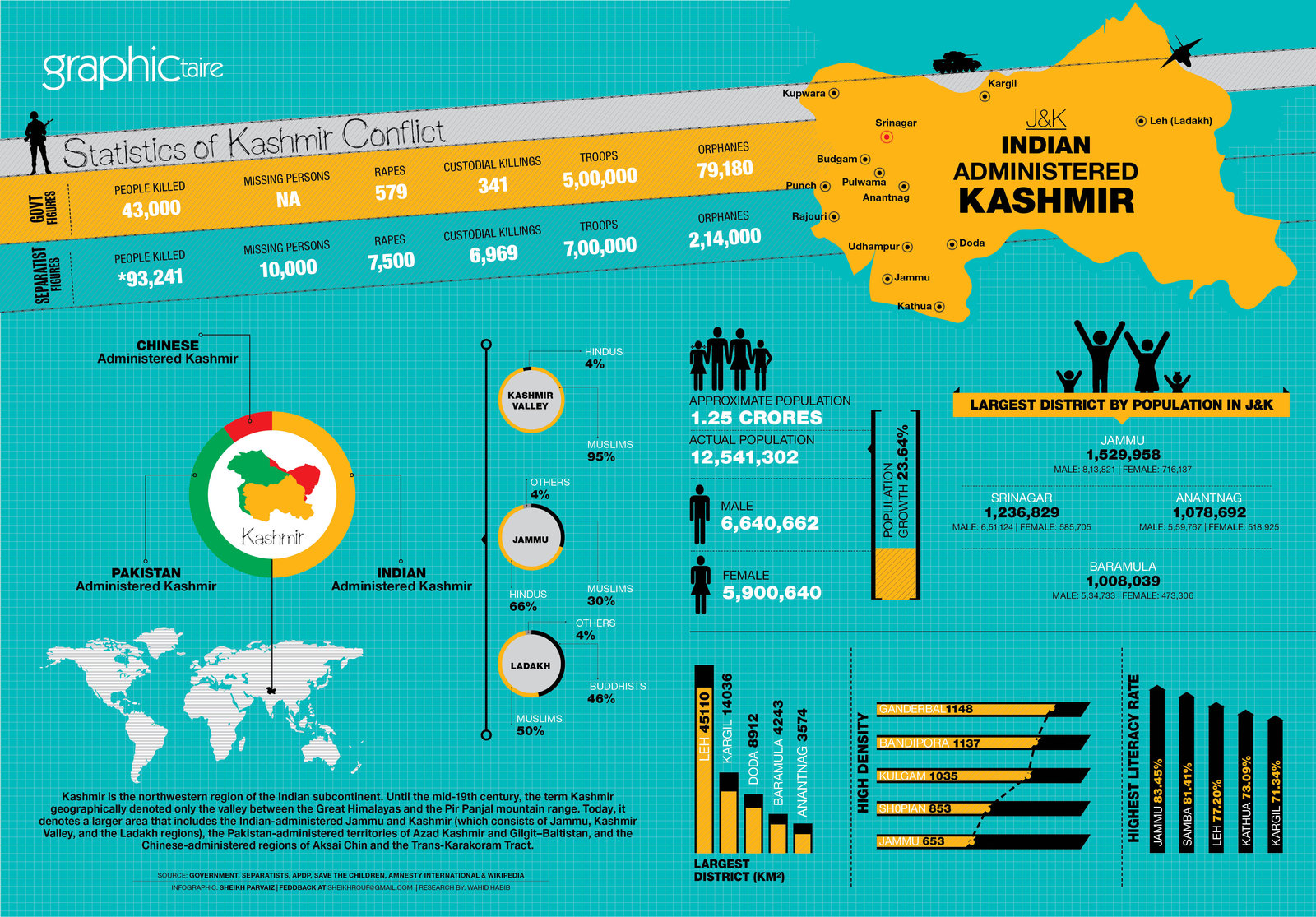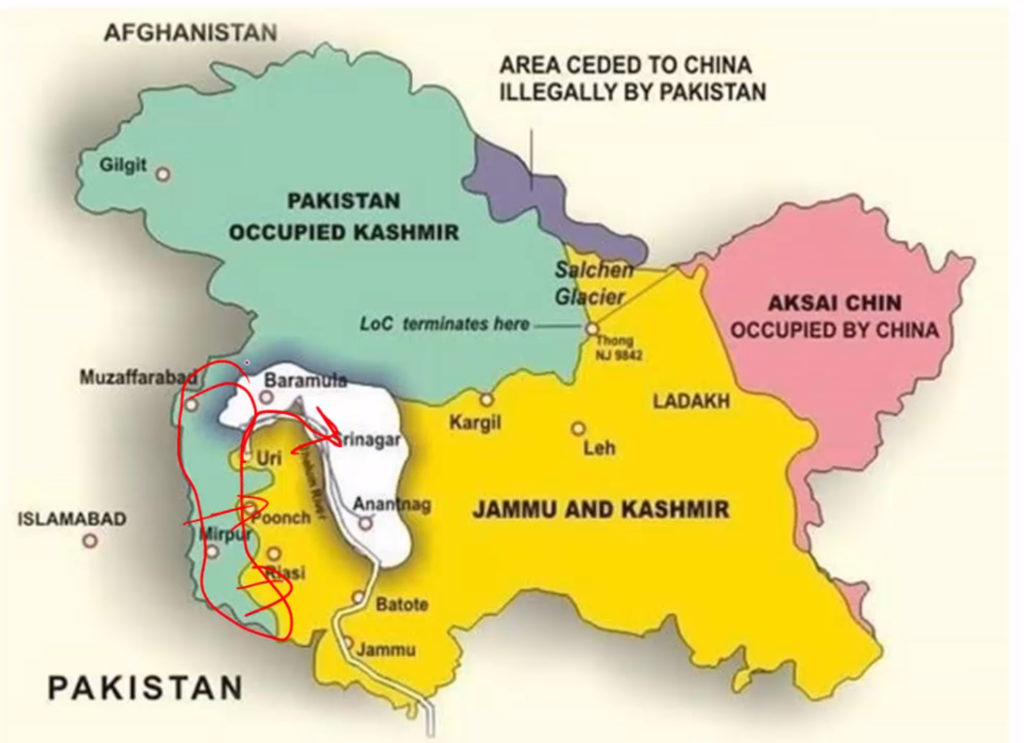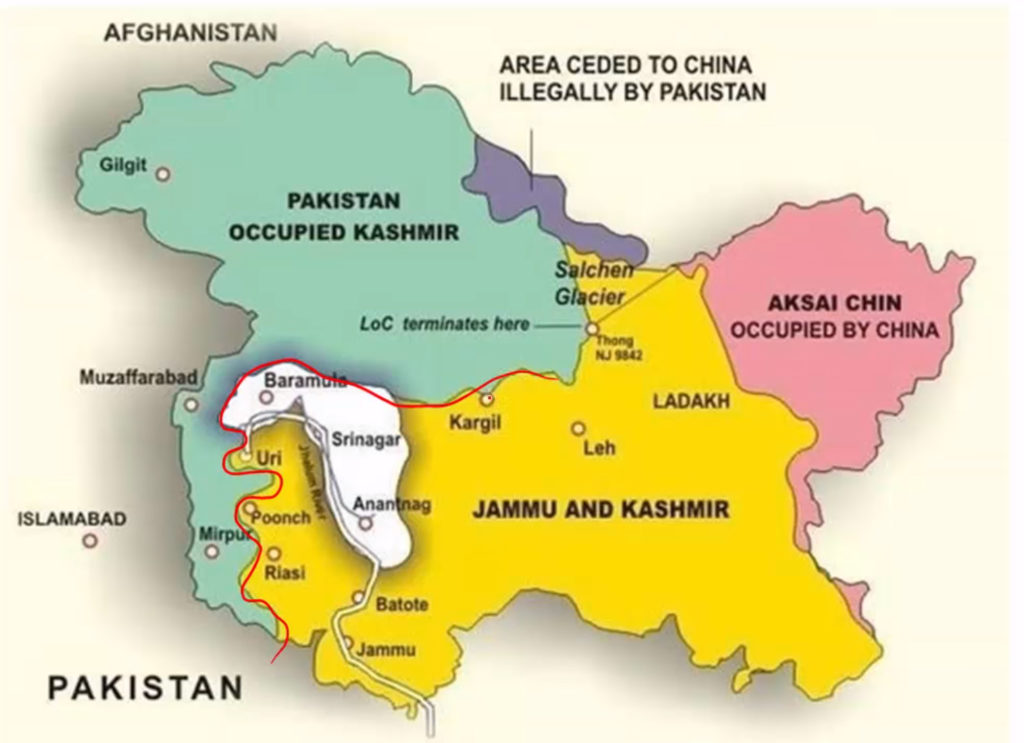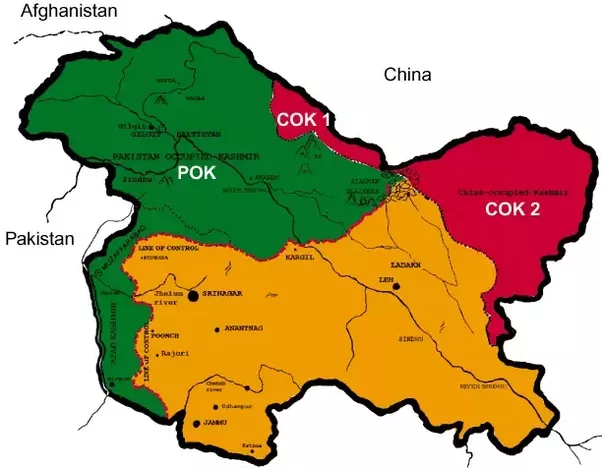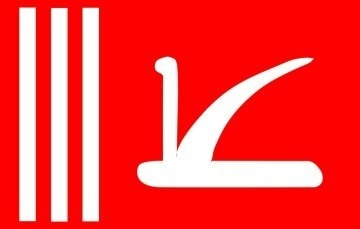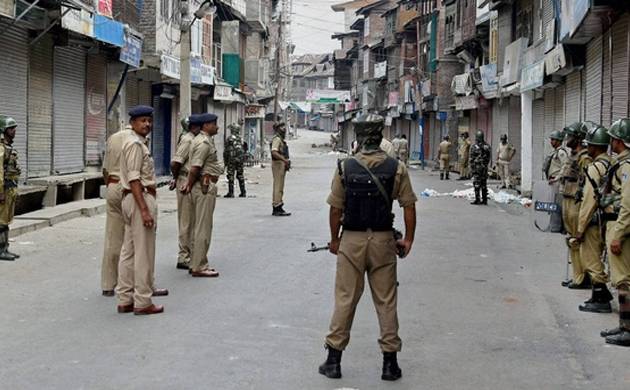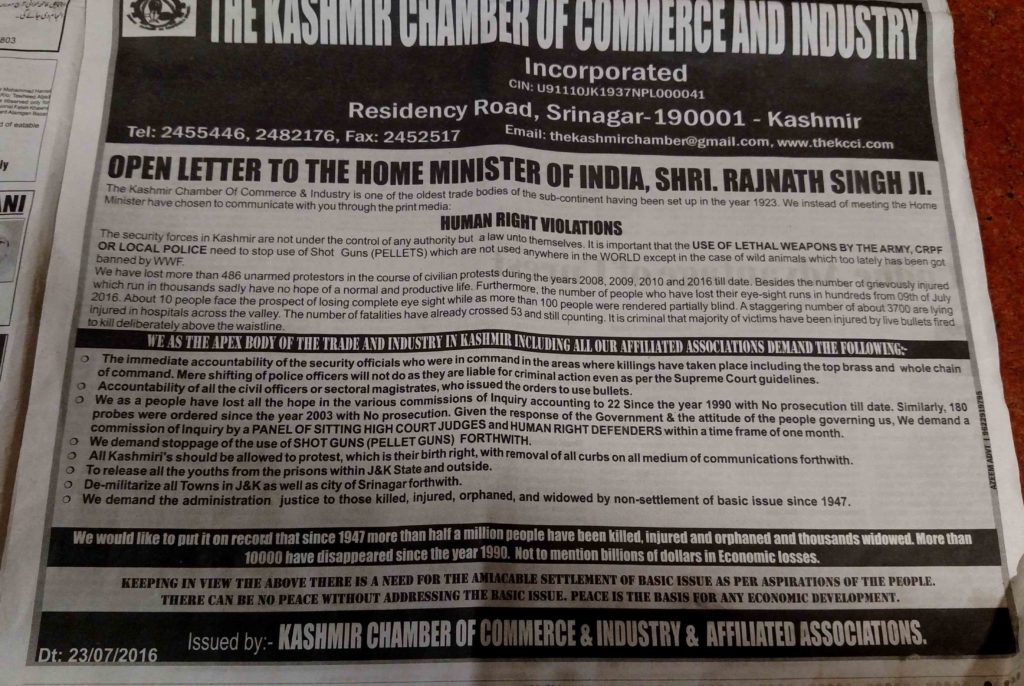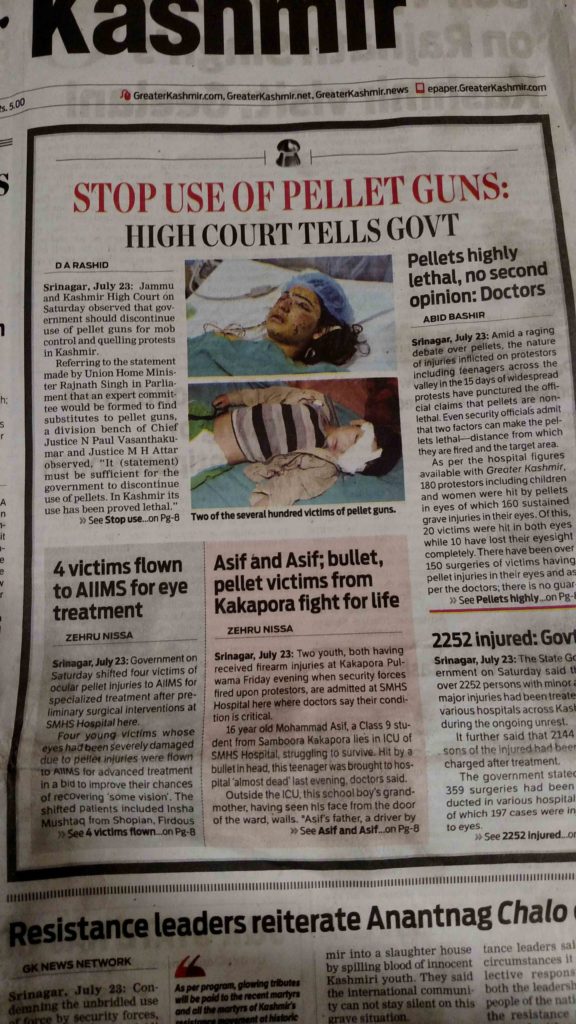This year we witness the 70th Independence day of India and 70 years of Kashmir Issue. We all know about Kashmir issue in bits and parts. If not in detail then at least one thing that two countries (actually 3) are fighting for a piece of land. In this article, I shall write about Kashmir issue in a bit detail. I have tried my best to take bits and parts from about 8 to 10 books in one article. I will first begin with the brief history of Kashmir.
Brief History of Kashmir
About 2300 years ago, Kashmir was a part of Mauryan Empire. Later on it was under Kushans Dynasty. They made Kashmir into a big learning center for Buddhism. King Kanishka of Kushans held 4th Buddhist council in Kashmir. After the demise of Kushans, Kashmir was ruled by various Hindu dynasties betwen 5th and 14th century. During 13th century, Kashmir came under Islamic influence and many people were being converted to Islam. Gradually, even the King of Kashmir converted himself to Islam and thus “Sultanate of Kashmir” was founded in 14th century. It continued upto 16th century. In 1586, it was conquered by Mughals under the reign of Akbar. By 1751, Mughals became weak and Afghans invaded and captured Kashmir under Durrani Emperor – Ahmad Shah Abdali. Later, Sikh ruler Maharaja Ranjit Singh defeated Afghans and took the hold of Kashmir. So it came under Sikh rule in about 1891. After the death of Maharaja Ranjit Singh, British defeated Sikh Empire with the help of Dogra Dynasty founder – Maharaja Gulab Singh. Dogra Dynasty is thereby also the founder of Royal house of Jammu and Kashmir. Gulab Singh was appointed as ruler of Jammu by Maharaja Ranjit Singh. But he supported Britishers in Anglo Sikh War. After winning the war, Britishers transferred the entire Kashmir area (Jammu, Kashmir Valley, Ladakh, Gilgit, Baltistan) to Gulab Singh in return for an indemnity payment of 7,500,000 Nanakshahee Rupees. This was in the year 1846 (approx). So from 1846 to 1947, Dogra Dynasty ruled Kashmir. Rulers were Hindu and majority of the population were Muslims.
When India-Pakistan partition happened, ruler of Kashmir was Maharaja Hari Singh, a descendant of Dogras. He neither wanted to be in India nor Pakistan. He wanted Kashmir to be Switzerland of Asia, An independent and neutral country.
There was a political party in Kashmir called “National Conference Party” (earlier known as Muslim Conference Party). They wanted democracy or self-rule in Kashmir and not the rule of a King. They wanted the King just to be the constitutional head but has no power and only parliament has all the powers. And so Sheikh Abdullah, along with other few people, founded this party in 1931. By 1947 this was the largest political party in JK and was also supported by Indian National Congress.
1947
In 1947, Jinnah argued that according to two nation theory (the basis of partition), the state of Kashmir with 77% Muslim majority should join Pakistan. And Maharaja Hari Singh, as mentioned earlier, wanted to stay neutral. But he signed a standstill agreement with Pakistan. It means “we will will continue to trade, travel, communicate, etc as it is but we will not join you. Things will remain as it is.” And he was also in talks with the Indian government to standstill agreement.
While these talks were going on, there was a rebel in Poonch (or Punch) area against state police and army. There was also communal violence in Jammu against Muslims. As you all know there were riots going on during Partition. During this period Pakistan supported tribal Pastun fighters from Northwest Frontier Province, NWFP (now known as Khyber Pakhtunkhwa) (If you happen to see Mahabharata map, you will find Gandhara there, yes, Gandhara is also happen to be the old name for NWFP). NWFP is the Pashtun dominated area of Pakistan. With the help of these Pashtun fighters Pakistan invaded Kashmir on 22nd October 1947. The reason they gave is they are here to help for rebel in Poonch and also the atrocities against Muslims. This was the official reason given by the Pakistan fighters.
As soon as these attacks happened, Maharaja Hari Singh’s army couldn’t stop it. He asked for military help from Indian Government. Indian government said, if you want military help, you need to join India. Thus, “INSTRUMENT OF ACCESSION” was signed on 26th October 1947. This means Kashmir joined India officially. As soon as this instrument was signed, Pakistan rejected it saying it was signed under pressure, by an unpopular ruler and it does not represent the will of the public. Even Sheikh Abdullah had agreed for Instrument of Accession.
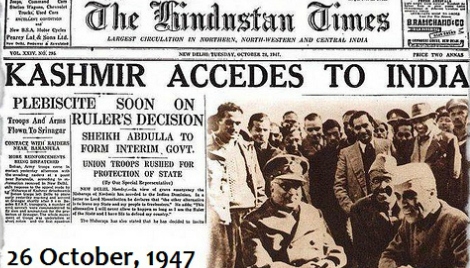
The accession was regarded as provisional until the time comes when the the will of the people can be ascertained once things are stable. It can be ascertained thru elections and constitution may be formed. Sheikh Abdullah endorsed the accession. He was a good friend of Nehru and Nehru also promised him that the will of people will be ascertained once the situation is stable. Sheikh Abdullah was appointed as the head of emergency administration by Maharaja.
Thus, the war of 1947-1948 begins. It is also called as First Indo-Pak war or First Kashmir war.
In this war Indian army airlifted its troops as there was no road connectivity to SriNagar. Heavy fighting happened at high altitudes, especially in the areas near Drass and Kargil. Army managed to push back the attackers to northern areas. Then there was winter. No fight can happen in winter coz of snow and all roads are blocked. Hence there was a stalemate in war. (stalemate is no one wins or loses).
While this war was going on, a provisional government was formed in western area of Kashmir by Pakistan and it was called as Azad Kashmir with Muzaferabad as its capital. Attacks were happening from Azad Kashmir to areas of Poonch, Uri and Baramulla.
Now India went to United Nations in January 1948 to resolve the Kashmir conflict. UN constituted a commission for India and Pakistan (UNCIP) and a security council resolution was also adopted. Resolution 47 of UNSC (UN security council).
UNSC gave 3 consequential non-binding steps. consequetial meaning 2nd step is to be taken only if 1st step is complied with and so on. Non-binding means it is not mandatory for India and Pakistan to follow this.
The 3 consequential non-binding steps were:
- Pakistan should withdraw all nationals and irregulars from Kashmir.
- India should withdraw its army and keep only a minimal force in the region required to maintain law and order.
- A plebiscite (vote of people) will take place to determine the will of the people directly.
Pakistan did not withdraw its forces and hence even India did not withdrew its forces. Stalemate continues. A ceasefire line was drawn and that became the de facto border of India and Pakistan in Kashmir region. Ceasefire line of 1948 was officially termed as Line of Control (LoC) in 1972 Shimla Agreement. In Shimla agreement both countries agreed to solve the Kashmir issue bilaterally. No third party will come in between. Earlier it was under UN.
CHINA
Now there is a new aspect to the problem. China occupied the area of Aksai Chin after the Indo-Sino war of 1962. After this war Pakistan wanted to solidify friendship with China and to do so it simply gave away a large piece of land as gift to China – The Trans-Karakoram Tract (Shaksgam Valley). Earlier there were only 2 countries involved in Kashmir issue and now there are 3, further complicating the problem.
Article 370
Sheikh Abdullah was made PM of Kashmir (not India) in 1948 and he headed the government till 1953.
Article 370 of Indian Constitution was framed to “temporarily” give few allowances to the state of Jammu and Kashmir. It gave the state some special powers like:
All the rules of Indian constitution are not applicable to JK state.
State assembly will have most of the powers
State head will be called PM instead of CM. Although later on it was changed.
Also, state of JK fly its own flag along with national flag. Yes, Jammu and Kashmir has its own flag. And there are many more special allowance in Article 370.
1953
In 1953, Sheikh Abdullah was removed from his post of PM by Central govt (led by Nehru) and was jailed for 11 years.
1964
In 1964, Sheikh was released and talks with Nehru began again. Nehru sent him to Pakistan to discuss the Kashmir issue. But while he was in Pakistan Nehru had died and again the talks were disrupted. Sheikh Abdullah was again sent to prison for few years by Indira Gandhi.
1974
In 1974, Sheikh Abdullah signed an agreement with Indira Gandhi and this was called as “Indira-Sheikh Accord”. According to this accord Sheikh dropped his demand of plebiscite (which he had demanded in 1948) and he became the CM of JK. He remained CM until his death in 1982. After is death his son Farooq Abdullah became CM.
1984
Indian army takes controld of Siachen Glacier under operation Meghdoot.
Insurgencies in 1990s
In 1987, assembly elections were held but were allegedly rigged to bring NC and INC to combine their powers. As soon as the results were out there was protest against this rigged elections. There were strikes, violence and protests that were out of control. Pakistan government and ISI took advantage of this situation. They promoted Jammu and Kashmir Liberation Front and Hizb-ul-Mujaheedin – 2 terrorists organizations to start a separatist insurgency (an armed rebellion against army / govt.). They also led the protests and also linked all their terrorists activities to the cause of independence of Kashmir. Initially, the protest started against elections but with terrorists groups they continue even today – against army and Indian government.
Many young Kashmiris were trained by militias and terrorist camps in PoK.
January 1990 – Genocide and Exodus of Kashmiri Pandits
In valley of Kashmir (entire Kashmir, only the valley of kashmir), Kashmiri andits were in minority. This ethnic community had been living in Kashmir valley since 100s and 1000s of years peacefullly. They were an affluent class of people even though theyw ere minority. They had goo positions in goverment, many were teachers in school, etc, basically they were well paid and lived. They were not poor. But in 1989, there was violence against these Kashmiri Pandits by the separatists. Many leaders of this community were killed publicly – high court judge, senior BJP politician, etc Around 300 were killed in few months.
By the time January 1990 came, insurgents were putting up public posts in newspapers and warning Kashmiri Pandits that they should leave Kashmir as soon as possible. Even loud speaker announcements were going on in day time to warn them to leave. On 10th r 20th January 1990, around 2.5 to 3 lakhs Kahsmiri Pandits fled overnight. They left their properties, houses, businesses, jobs and everything and fled to Jammu. Even tday, after 25+ years, many of them are living in camps and tents in Jammu and Delhi areas and still in deplorable condition. This entire episode is also known as ethnic cleansing of India. It means removal of entire ethnic of people from certain area.
The militany and violence that started in 80s led to the government of India to apply Armed Forces Special Powers Act (AFSPA) in JK in 1990. AFSPA gives special powers to the police and army.
Few of many special powers are:
- They can arrest any one without warrant.
- They can arrest any one found doing any suspicious activity.
- They can shot people after giving a warning, no need to arrest or carry out any investigation.
- and many more.
AFSPA was necessary coz of large scale violence that was going on.
The government had already resigned by 1990 – govt of Farooq Abdullah which had come to power in 1987. There was complete Lawlessness in the state of JK and that is why Kashmiri Pandits could not be saved. There was no got to protect them.
Due to absence of govt, there was now Presidents rule and thus AFSPA was introduced.
Throughout 1990s and early 2000s, there was heavy infiltration of terrorists and attacks. Indian army carried out counter insurgency operations against this infiltration of terrorists and attacks. Uptil 2004 violence was there in large scale. After 2003-2004, militancy has subsided to a good extent but it is still present. Even today we see ews atleast once a week on Kashmir violence or attacks but it is nothing compared to 1990s.
Infact, in 2014, 65% people in Kashmir came out to vote, which is a very good percentage.
In 2016, due to demonetization, Kashmir saw dip in terrorism. No stone pelting on forces in Kashmir after demonetization move. Even as on date I cannot comment if the violence in Kashmir is paid or not.

